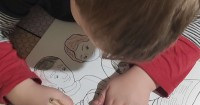The Benefits of children’s Fine Motor Skills Development through coloring
Coloring is a simple and fun children's activity that helps children develop cognition, creativity, imagination, and more. A child with crayons is a classic depiction of childhood. They can hold crayons in their hands after a year, but this activity is far from coloring in the lines. These little ones are trying out what will happen when they pull on the paper with crayons.
Coloring requires more hand and finger coordination. Fine motor skills are essential for most school activities, but these skills are important in life. Delays in fine motor skills can affect the ability to perform the basic activities of daily living, such as eating, dressing, or grooming. If your child lags in developing fine motor skills, she may be able to write, turn pages in books, or use a computer. Some kids struggle with their fine motor skills development because these skills require more precise movements of small muscles, more control, and better coordination.

Motor skills are needed to develop grip, muscles, and hand strength
The actions, motions, and precise grip involved in coloring can aid in developing the muscles of the fingers, hands, and wrist. Fine motor skills can help children write more skillfully and manipulate small objects. They can then build on these skills to become better typists and more adept in sports and other activities.
Children need to develop fine motor skills to hold a crayon. They also need hand strength to color in shape and visual motor skills to color within the lines. Coloring also helps children develop good finger grip. It provides an opportunity to practice holding a pencil the correct way and aids in developing those fine motor muscles in their hands, fingers, and wrist.
Coloring with crayons, markers, or colored pencils helps kids learn to gain greater control of holding things with their hands, which is essential for writing and, consequently, school success.
Focus not on the child's coloring perfection but on his interest and curiosity
Encourage your child to paint and draw. These activities promote the development of fine motor skills and encourage cognitive abilities, creativity, and imagination. Different painting and coloring supplies like chalk, charcoal, finger painting, or puff paint will spark your child's interest and curiosity and strengthen his hand-eye coordination.
Another great art activity for toddlers and older kids is an easel-coloring or painting. A standing easel toy promotes fine motor skills by strengthening your child's wrist and developing fine motor of her fingers. In addition, this activity encourages gross motor skills as the child is required to stand while painting.
Your child's drawings and illustrations can be imperfect. Scribbling is enough to practice fine motor skills. Display your child's artwork around the house. It will boost self-esteem and confidence.

